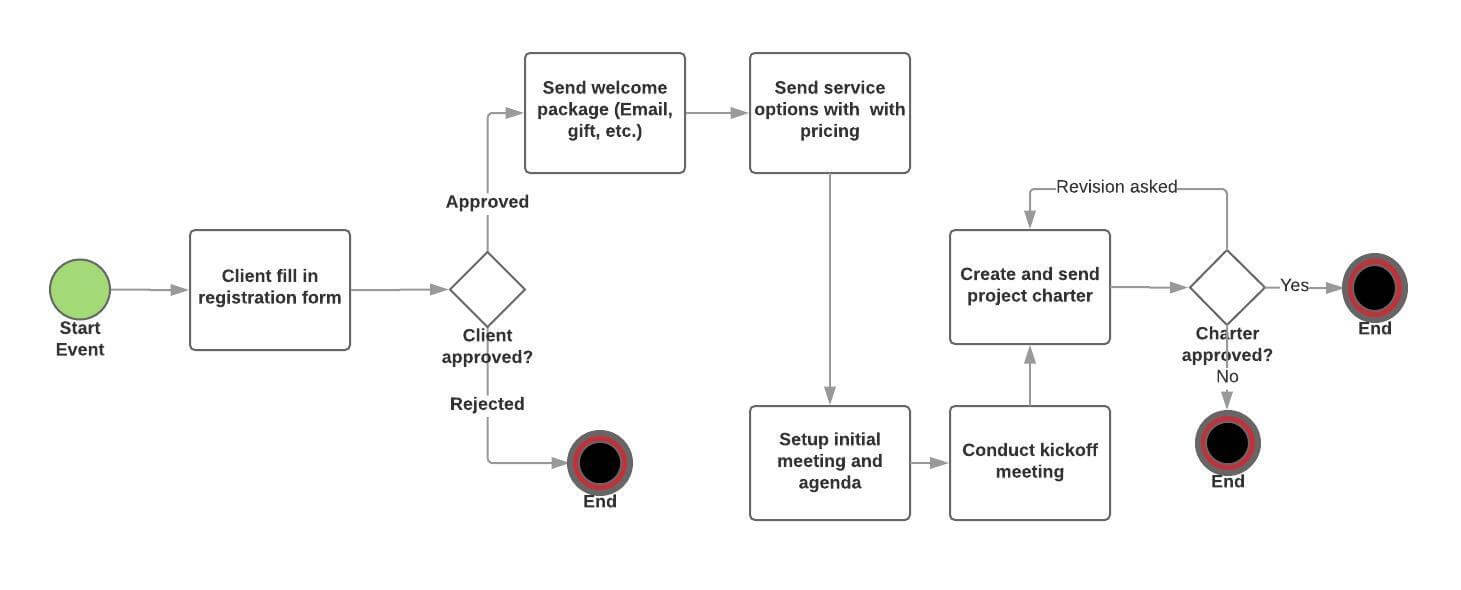When carrying out business process improvement, it’s essential to start by documenting and analyzing the As-Is business process. This helps you gain the insight you need on the inner workings of a process, allowing you to come up with potential improvement ideas.
How to Document an As-Is Business Process
By definition, an “as-is business process” is the current state of the business process. Documenting it is essential for understanding how the process works and what the inefficiencies are so that you can later make improvements or even redesign the process entirely.
It’s usually used for 3 reasons…
- Process Improvement – Understanding what’s wrong with the as-is process and figuring out how to improve it
- Process Documentation – Your new employees won’t know how any of the processes work. Rather than having to explain it over and over again, you can just show them the documented process.
- Process Standardization – Everyone in the organization is carrying out the process in a different way. You’d want to document the best way to do it make everyone aware of it
Before you can actually analyze the as-is process, though, you should create a process map.
The first step there is to actually understand the process. The most common mistake managers make here is assuming they’re the expert on any process.
In reality, though, process improvement ideas rarely come from the C-suite. It’s from the people who really understand the ins and outs of the process: your employees. So let’s say there’s a problem with employee onboarding. To get a good idea on how to improve the process, you’d need to talk to everyone involved in the process: the HR, office manager, and the department supervisor.
Then, once you’ve established who’s involved, you need to get the right information. This is usually done by either observing the process or interviewing the key employees.
When you’ve gathered all the information, you can actually start with the process map.
The simplest way to do this is with a flowchart – simply putting down the steps of a process as they are. So for example…

In other cases, if you’re trying to do a specific type of analysis, there’s the value stream map, SIPOC diagram, etc.
There are different ways to map a process…
- Pen & Paper – The most straightforward approach. Grab a pen and a piece of paper and draw the process as a flowchart.
- Flowchart Software – Tools dedicated to creating process flowcharts. These are more useful if you’re planning on sharing the documented process with your employees digitally.
- Workflow Software – Works pretty much the same as a flowchart software. The main difference is that it also allows you to digitize and track the process. This tends to help with process standardization (no one can deviate from the best practice), as well as automation(the software reminds you whenever it’s your turn to do something in a process, as well as enforcing deadlines)
If standardization or documentation is your main goal, you’ve already done your job once you have the process map. If, on the other hand, you’re going for process improvement, then you need to analyze the as-is process.
How to Analyse the As-Is Business Process
Since every process is completely different, there’s no one-size fits all formula for analyzing it. You can try asking yourself the following questions, however, for gaining insights.
- Are there missed deadlines for the process? Why?
- Which steps have the highest impact on process output? Think, product quality, price, etc. Is there any way to automate them? Make them more efficient?
- Are some of the steps taking longer than it’s reasonable? Are they costing you more than what would be reasonable? Why?
Other than that, you can also use several process analysis techniques such as the 5 Whys to gain more insight into potential improvements. The gist of it is, whatever issues you have with a process, you keep asking “why” until you find the root cause of the problem.
From As-Is to To-Be
Once you have a good idea on how to improve the process, you need to create a to-be process map. That’s the future step of the to-be process – how the process will be after you make changes and improvements to it.
The to-be business process will help you put the changes you want to make down on a map and finally implement them.
Related Questions
What is the difference between as-is and to-be process?
The as-is process is the way business currently operates and the to-be process is the future, improved state. Think of it as a picture of today’s workflow, warts and all. The to-be process is a metaphor, a makeover, for imagining how things might work better. This sort of comparison helps teams identify areas for improvement and plan workflow changes that make working together smoother and more efficient.
What is process mapping as-is?
So process mapping as-is is drawing a map of how work flows through your organization as it exists today. Picture following a paper trail through your office, and noticing every step, every delay and every decision point you come across. This visual helps everyone involved to see the present process in a clear way, making it easy to pick up on bottlenecks, redundant steps, and areas where things tend to go wrong. It’s a crucial first step in the process of improving any workflow — you can’t fix what you can’t see.
What involves in as-is analysis?
As is analysis is the equivalent of being a detective in your business. You collect clues by observing how the work gets done, talking to the people who do it, and examining any data or documents they use. This research helps you know what’s what inside and out right now. You’ll reveal the good, the bad and the ugly – from ingenious workarounds staff have come up with to infuriating obstacles which grind everything to a halt. The aim is for readers to get a realistic, candid sense of how things actually work (as opposed to how they are supposed to work on paper).
Why would a manager need to review an AS/IS and to-be a process model?
A manager looking at AS/IS and to-be process models is similar to a coach watching game tapes. The AS/IS model is a description of how the team is playing today, while the to-be model is the new recipe for winning. By comparing these, the manager can see precisely what must change — and why it must change. This retrospective aids in budgeting resources, bracing the team for a shift, and establishing achievable objectives. It is also a strong way of demonstrating to higher-ups why changes are necessary and how they will pay off, making it easier to secure approval for improvements.
What are steps of as-is process analysis?
As-is process analysis is almost like a puzzle. The first thing to do is to collect the pieces while learning what the current process is like. Next, you shove them in together, connecting them by plotting each step. Next, you “stare down” your finished puzzle to see things such as how long each step takes or where mistakes occur most frequently. From there, you brainstorm with your team to determine what’s working well — and what’s giving everyone a headache. Lastly, you describe your findings and the most significant challenges and potential for improvement. By “walking you through” a process step by step, you are less likely to forget details and are better-prepared to design a better process.
How the As Is – To Be Model Works
The As Is – To Be model functions something like before-and-after photos on a home renovation show. The snapshot of “As Is” describes how you’re doing business now, messes and all. Then, like designers designing a beautiful new kitchen, you and your team envision a slimmer, more efficient “To Be” process. It all happens in the in between where you plan and make changes to bring about your new workflows. This framework helps keep everyone’s eye on the prize and a point of departure. It’s a driver for change and a way to help teams visualize improvements as they guide their way through the renovation of their business processes.
Related Questions
What is a business process designer?
Think of a business process designer as the master architect of your company’s operations. They delineate the process a business follows on the way to the fulfillment of its goals, and ensure that process connects harmoniously from step to step. These inventive problem-solvers look at how work is done, see where it can be done in a more efficient way, and then figure out clever new ways to make everything run better. They are the ones who make messy, confusing workflows into clean, efficient paths that all can take.
What is business process design with example?
Design of business process is like preparing a recipe for success in an enterprise. Consider a coffee shop wishing to provide a faster service to its customers. The process designer might map out each step from when a customer enters to when that customer walks out with a drink. They could propose having one person take orders while another prepares drinks, or implement a mobile app for pre-orders. The idea is to make the entire process smoother and faster for both customers and staff.
What are the three types of business process designs?
The three primary tastes of of business process design, are like approaches to solving a puzzle. There is, first, the “as-is” process, examining the way things are done now. Next is the “to-be” process, which dreams up what an ideal state would look like. And then there’s the “gap analysis,” which determines how to close the gap between the present state of things and the desired ideal. Both types are essential in moving an organisation from where it currently is to where it wants to be.
What are the three 3 key aspects behind business process design principles?
The three main design principles of business process might remind us that it is like the special components of a good recipe. To begin there’s simplicity – the idea of keeping things easy to follow and understand. Second is flexibility — processes you design to be flexible and adaptable. Third is that everything should be efficient — that you don’t waste your time doing one thing when you could be killing two birds with one stone. Once these three elements are combined, you have processes which are not only effective, but also flexible and future-proof.
Why is Business Process Design Important?
Business process design is critical for the same reason that an excellent map is necessary for a road trip. It’s assistance that helps companies learn to better manage the labyrinthine world of business. By specifying how work is to be done, it minimizes confusion, streamlines production and ensures that everyone knows what is expected of them. Add to that the fact that a well-designed system of processes can be a real advantage for a company — making it more nimble, more productive
How Do You Decide Between BPM and WMS?
Deciding when to use a BPM tool versus a Workflow Management System (WMS) is akin to deciding which tool is right for the job. BPM is just that, like a Swiss-Army knife – great for the complex, company-size, process headaches that require more than one department to get the job done. WMS, on the other hand, is like a very practical device – it will help you do some specific and repeated thing more effectively. It all depends on what you need – if you will be rethinking your whole business process, BPM might be the answer. But if you simply wish to standardize how certain tasks are performed, WMS might be the better fit.
What are the benefits of business process design?
The advantages of business process design is equivalent to striking gold in the business industry. It can be a huge efficiency booster, a time and money saver. It makes consistency I mean, the work is done the easy way and the best way, instead of the good way, and it leads to better quality. It creates more transparency, making it easier to diagnose and fix problems. Most importantly, it can drastically improve customer satisfaction by providing smoother and more reliable services. Good process design can, in effect, turn a failing business into a business machine.

